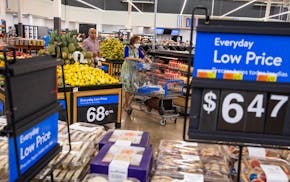A T-shirt bought from Target might be 100% cotton, but that doesn't necessarily explain the garment's whole history.
Companies looking to sell guilt-free garments have long struggled to track a global supply chain that spins out 54 billion pounds of cotton per year. Traceability is important, because among the world's 10 largest cotton-producing countries, seven are facing accusations of using child or forced labor.
Minnesota companies Cargill and Target have responded to consumer demand for transparency in clothing and textiles by teaming up with a tech company that can follow the fabric around the world. FibreTrace uses a digitally trackable pigment that follows a bale of cotton from initial processing to finished product.
"The way the cotton industry works, it's hard to differentiate once it's in the supply chain," said Mitch Standen, global head of operations for FiberTrace. "It all comes down to knowing where your product is, when and where it was produced, and verifying that information with a scan."
Cargill, one of the world's largest buyers of raw cotton, will use the technology on 50,000 tons of cotton from the U.S. and Brazil this year that will end up in products on Target shelves early next year.
"It's not unlike food: People want to know where their food is coming from, and people want to know where their clothes are coming from," said Krista Rickman, who leads cotton sustainability programs for Cargill. "The textile industry is very complex, and we're working at the start and end of supply chains to make change."
For Target, it's both about meeting consumer demand and living up to its own corporate pledges
"Achieving full visibility to where the cotton used to produce our products is grown is among the top priorities of our sustainability goals," Bill Foudy, president of owned brands at Target, said in a statement.
Target's cotton policy states the retailer "does not knowingly buy or sell products that are made, in whole or in part, using forced or underage labor." The company specifically doesn't accept products with cotton from Turkmenistan or China's Xinjiang province, where forced labor is reportedly widespread in cotton fields.
But as cotton moves around the world from field to gin to mill, one farm's crop often becomes an anonymous thread. Even when bypassing the global supply chain, direct sourcing can be prohibitively expensive for many consumers because it lacks the efficiencies of scale.
Standen said FibreTrace can back up sustainability claims, like a farm's regenerative practices, as tracked cotton appears on shelves. It could also rein in costs with real-time shipping and inventory data rather than relying on paperwork and phone calls for sourcing. That all makes the business case for traceability stronger.
Globally, 75% of consumers said they are willing to pay up to 5% more for transparency in their clothing's origin, according to a PwC survey last year. Less than a third, though, said they would pay more than a 10% premium.
Rickman said cotton tracing is a lot like adding features when buying a car: pay more, have more. And with enough demand, traceability could become a standard feature.
"Change is not easy. It requires a commitment from everyone who wants to do better," Standen said. "It's great to see the industry moving forward on a corporate basis as well as driven by the consumer."
Minnesota's med spa industry rises in popularity — and with little regulation

Ramstad: Readers say Walmart won't be paying the ultimate price of Trump's tariffs

How Minnesota businesses can spot and prevent invoice fraud
No place for cryptocurrency in retirement portfolios

